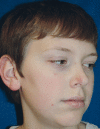Successful reconstruction of complex pediatric nasal lesions: improving outcomes using dermal regenerative templates
- PMID: 25289301
- PMCID: PMC4173827
- DOI: 10.1097/GOX.0000000000000033
Successful reconstruction of complex pediatric nasal lesions: improving outcomes using dermal regenerative templates
Abstract
Background: Dermal regenerate templates are currently widely used in both adult and pediatric burn reconstruction. Despite this, the safety and efficacy of regenerate templates combined with full-thickness skin grafts for the reconstruction of pediatric facial defects traditionally treated with local flaps is not widely published. The aim of this study is to report the safety and efficacy of pediatric nasal defect reconstruction using regenerative templates/full-thickness skin grafts.
Methods: A retrospective review of one institution's experience with pediatric nasal defects treated with regenerative templates was performed. All patients (n = 4) were treated with a multistage protocol. Two reviewers independently assigned Visual Analogue Cosmetic Scale (VACS) scores: 1 surgeon and 1 nonsurgical researcher not involved in patient care. Standardized photographs (anteroposterior, oblique, lateral, and worm's eye view) were assigned VACS scores according to a 100-point scale: "abhorrent," 0-24; "poor," 25-49; "moderate," 50-74; and "excellent," 75-100. Statistical analysis was performed using Mann-Whitney U and Wilcoxon paired signed-rank tests.
Results: Four patients (2 boys and 2 girls, average age 6.8 yr) who met the inclusion criteria were identified. A total of 5 nasal lesions (2 spitz nevi, 1 vascular lesion, and 2 congenital nevi) were removed. The preoperative VACS score was 45.2 (range, 5-70), compared with 84.5 (range, 45-100) postoperatively (P <0.000). There was no significant difference between raters (preoperative, P = 0.346; postoperative, P = 0.678).
Conclusions: The reconstruction of complex pediatric nasal lesions using dermal regenerative templates and full-thickness postauricular skin grafts is safe and effective, and associated with low morbidity and significant improvement in VACS scores.
Figures








References
-
- Ozerdem OR, Wolfe SA, Marshall D. Use of skin substitutes in pediatric patients. J Craniofac Surg. 2003;14:517–520. - PubMed
-
- Bannasch H, Kontny U, Krüger M, et al. A semisynthetic bilaminar skin substitute used to treat pediatric full-body toxic epidermal necrolysis: wraparound technique in a 17-month-old girl. Arch Dermatol. 2004;140:160–162. - PubMed
-
- Stiefel D, Schiestl C, Meuli M. Integra Artificial Skin for burn scar revision in adolescents and children. Burns. 2010;36:114–120. - PubMed
-
- Blanco NM, Edwards J, Zamboni WA. Dermal substitute (Integra) for open nasal wounds. Plast Reconstr Surg. 2004;113:2224–2225. - PubMed
-
- Thornton JF, Rohrich RJ. Dermal substitute (Integra) for open nasal wounds. Plast Reconstr Surg. 2005;116:677. - PubMed
Grants and funding
LinkOut - more resources
Full Text Sources
Other Literature Sources
Miscellaneous
